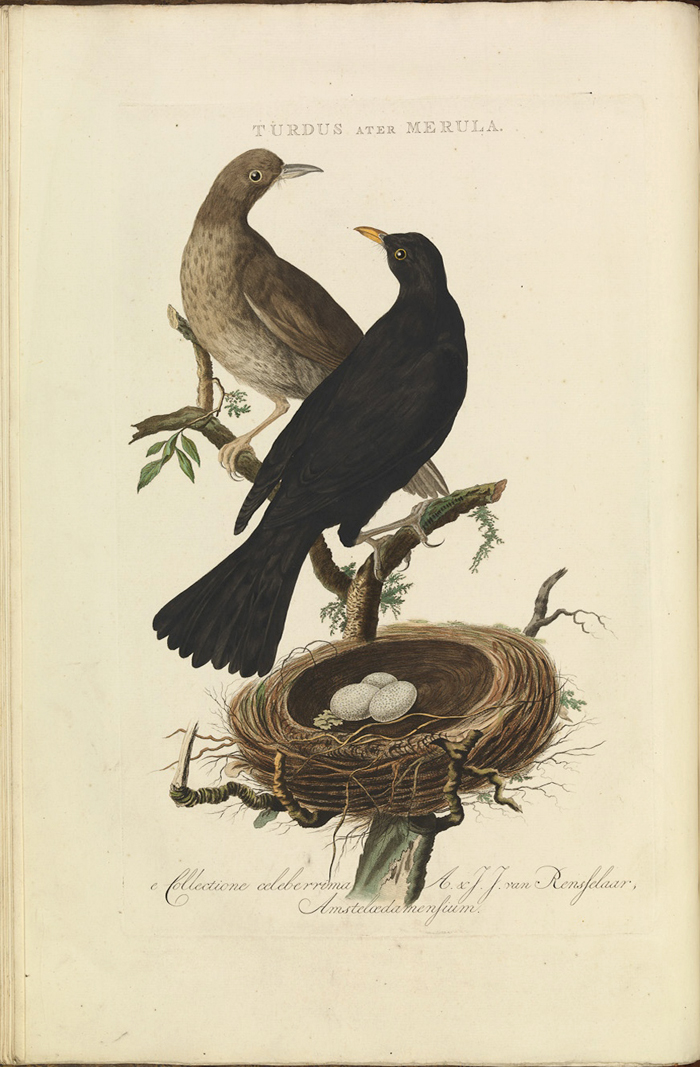Lightning Ellipse

Site-specific circuit
6-channel audio, live-input telluric currents, Basilica di San Marco reverb, 49 min lightning storm ground transduction loop, common blackbird (Turdus merula) vocalizations.
Lightning Ellipse is a site-specific circuit, installed in the portico of the French pavilion in Venice, patching together earth’s native transmissions (lightning), received on ground telluric currents, passing through contextual features of the site. The sound installation relays electrical activities from the ground beneath the French consulate in the Netherlands, during a recent torrential thunderstorm that quenched a record-breaking dry-spell, played back through agencies of Venetian echo (acoustics of Basilica di San Marco) and geometries of architecturally broadcast voice (the pavilion’s elliptic portico) interspersed with the call-and-response of a common blackbird.
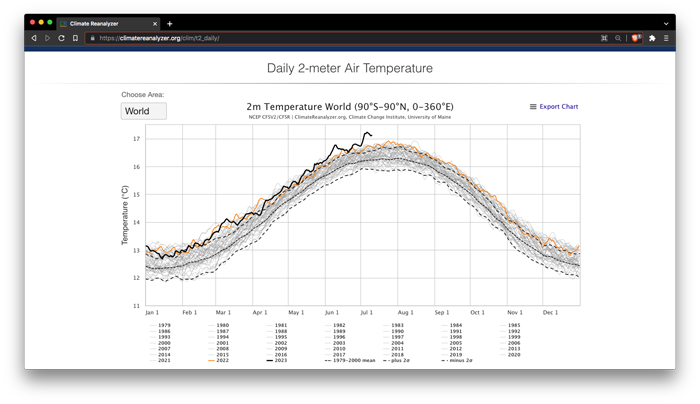
Springtime in the Anthropocene
Average global temperature broke records on Monday and again on Tuesday in first week of July. The data was captured in froth-like turbulence atop a larger wave of accumulated summer swells of the global heat index. [01] Since early March, the North Atlantic has never been warmer and Holland just emerged from its longest sunny period since weather monitoring began. Human-induced heat waves —and related torrential rains, hailstorms, landslides and flooding— are currently toppling records across the globe. [02] Excessive groundwater pumping from the planet's interior is shifting earth’s tilt. [03] Earlier this spring, Californian hills flooded with color in an unprecedented ‘superbloom’. The term blissonance —an unsettling mix of awe and horror— has recently been coined to describe situated experiences of unusual natural phenomena linked to human-induced terrestrial pressures. At the same time psychologists and academics are scrambling to contain a growing wave of distress symptoms collectively known as climate anxiety or eco-anxiety. Becoming acquaintance with these globalized pressures and situated oscillations provides leeway into their unprecedented complexities.
A single recording of ground electricity during the torrential thunderstorm that broke the record-breaking 38-day long dry-spell in Amsterdam —recorded from the ground beneath the French consulate in Amsterdam on June 20th 2023— provides the source signal for the Venice pavilion circuit. The recording includes ongoing activities the Earth’s native telluric currents, periodic clicks from lightning inductions, and the ubiquitous drone of anthropogenic 50 Hz power-mains hum. The length of the telluric recording is precisely 49 minutes: the duration of the thunderstorm passing through the consulate grounds.
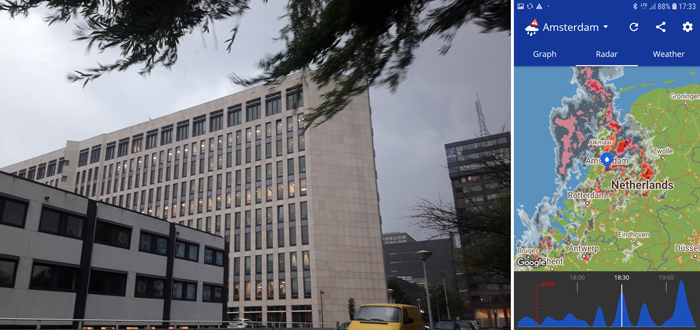
Earth’s Native Transmissions
Lightning is earth’s native electronic transmitter. The birth of radio communication also signaled the domestication of lightning, though nearby thunderstorms are still readily received on AM radios as faint irregular crackling corresponding with the intermittent lightning emissions. [04] Transmissions of world-wide lightning bolts —averaging 50 strikes per second— crisscross the atmosphere, rebounding off the ionosphere and surface of the earth, at times circumnavigating the globe. These ongoing electromagnetic activities resonate the spherical hollows of the ionosphere, producing a distinctive overtone pattern known as Schumann resonances. Recently its been discovered that the intensity of ringing is closely coupled with atmospheric temperature variations also linked to sea level rising. Data from long-term monitoring suggests that an increasing ringing is the electromagnetic reverb of global warming. [05] As global temperatures increase, so does the humidity in the air, producing thunderstorms and torrential downpours, resulting in unprecedented hail and flooding this summer in Italy, Spain, China, India, Japan, US and Slovenia so far. [06]
As radio lightning silently passes overhead, skipping across the earth-ionosphere waveguide, it induces electrical charges in nearby ground, manifesting localized territories of the global atmospheric electrical circuit. The source of the sounds circulating in the Lightning Ellipse are tapped off of two electrodes in the ground beneath the French consulate in Amsterdam, and transposed to the French pavilion in Venice. The distinctive crackling, also known as sferics, picked up in telluric currents from the ground, relay live broadcasts of lightning not only from the thunderstorm passing overhead but also more distant crackles from storms occurring in equatorial and tropical regions, hundreds (even thousands) of kilometers away.

Venetian Reverb
The labyrinthian acoustics of Venice is mirrored in the musical materiality — especially in the late works — of the Venetian composer Luigi Nono. Speaking from his home on Giudecca, Nono gestures to the polyphony of local oscillations, overlapping rhythms and distant murmurs accentuated in the specific reverberations of Venice’s aquatic and predominantly pedestrian surrounds. [07] The coexistence of contrasting sounds from lagoon birdcalls, polyrhythmic bell tolls and mundane vernacular sounds of domestic life, project along narrow alleys and stone-clad canals, collecting in piazzas and open reverberant waterways.
From the tangle of Venetian sounds one set of echoes stands out in particular: those emanating from St. Mark’s Basilica, whose interior space is considered the singular juncture in developments of Western spatial music. Arguably, Venice’s aquatic urbanism fostered complex modes of spatial hearing whose agencies materialize early on, manifesting in Basilica di San Marco’s idiosyncratic reverberations that are inextricably bound with developments in polychoral music and more specifically ‘cori spezzati’ (divided choir) techniques, exemplified in Giovanni Gabrieli’s works written for the Basilica in the 16th century. [08]
More troubling sounds are also intermittently heard reverberating in San Marco caverns. Shortly before the completion of the city’s MOSE seawall protection system, the crypt below St. Mark’s was considerably damaged from flooding in 2019. [09] San Marco sits on the lowest point in Venice in a flood-prone region of the lagoon. Images of partially submerged legs in the flooded plaza of Piazza San Marco have long been the measure for rising Adriatic tides.

Sounding the Ellipse
Geometries of the ellipse are central to the prehistory of voice transmissions, particularly in architectural domains. In 1765, the French architect and urban theorist Pierre Patte published schematic outlines for an ideal theatre at a time when European architecture was courting utopian fantasies. The Plan d'un Théatre suivant les Principes in his treatise on theatre architecture Essai sur l'Architecture Théâtrale — unmistakably resembling the plan of Teatro Regio in Turin completed two decades earlier — canonizes the ellipse at the core of vocal-centric theatre designs. [10] Patte believed that voices were ellipse-shaped because of their directional propagation. In contrast, bell sounds were thought to propagate spherically. Placing vocal emissions at one of the geometric focal points while situating the other at the rear of an audience aimed at foolproof theatrical reception guided along concavities of the ellipse.
It was generally accepted at the time that concave surfaces were advantageous for acoustical designs because they ‘concentrate’ and ’preserve’ sound. Earlier acoustic investigations of curved surfaces — such as depictions of voices projecting through the ellipsoidal vault of a Heidelberg palace by the Jesuit scholar Athanasius Kircher in 1673 — determined voice transmissions between two distinctive points coinciding with the geometrical foci of an ellipse. [11] Drawing sounds as linear geometries expresses a ray-tracing propagation model, steeped in earlier optical analogies, which eventually became one of two predominant models for sound-specific architectural designs well into the 20th century. The alternative sonic model, posited by the physicist and founder of architectural acoustics Wallace Sabine, was known as the ‘bathtub’ analogy, likening the energy distribution of chamber reverberations to the sloshing of liquids trapped in a basin, not unlike Adriatic waves reverberating in the Venetian lagoon. [12]
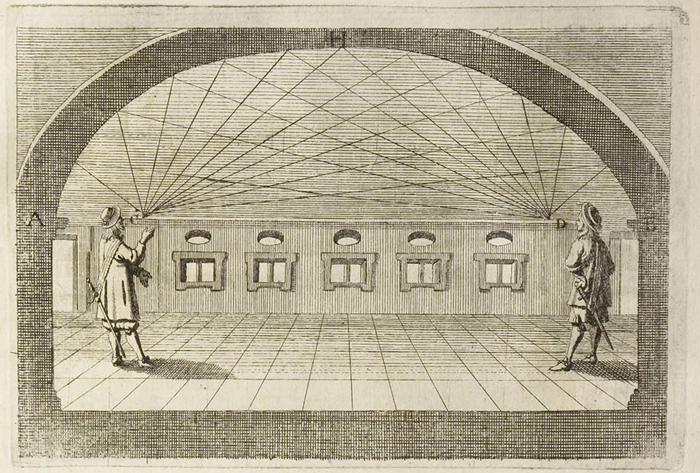
Pavilion Circuit
Travelling voices sustain an insular presence in elliptical halls, skipping back and forth between immobile geometrical centers while turning their back on the space in between in a manner that foreshadows the point-to-point communication currently flooding terrestrial space. First through the point-to-point grounded transmissions over telegraph wires, then through the sprawling tangles of telephone lines and finally over wireless transmissions, increasingly materializing a sender-receiver electronic model of communication, that systematically diminish ambiences of their transmission medium as well as interloping hubbub at their source locales.
The noticeably reverberant interiors of the French pavilion at Giardini, built by Faust Finzi in 1912, were completed just moments before Sabine’s acoustic dampening paradigm took root in the architectural profession. Curiously the building incorporates a carry-over from former theatre designs — an ellipse. The French pavilion’s ellipse is somewhat concealed in the concavity of the portico, its other half is broken open, leaving a gap through which surrounding ambient murmurs flood in. In the Lightning Ellipse installation, the geometrical foci of the portico are occupied with a pair of loudspeakers relaying avian sounds of a common blackbird, also common to Giardini’s greenery. Resident lightning, picked up from telluric currents in the ground beneath the pavilion, triggers a blackbird song in extended granulated phonemes. The bird’s call-and-response —possibly an antecedent of cori spezzati— intermix with incidental chirps and buzzing from other resident birds and cicadas, that together with the sounds of rustling leaves and empty snack bags, rhythmic gravel and human chatter get engulfed in the persistent reverberant crackle of future tidal oscillations.
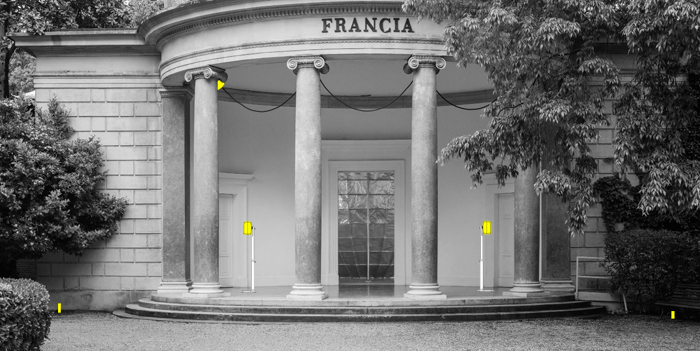
Notes
[01] University of Main, Climate Change Institute, https://climatereanalyzer.org/clim/t2_daily/
[02] Harvey C., Heat Waves Fueled by Climate Change Topple Records around the Globe, Scientific American. https://www.scientificamerican.com/article/heat-waves-fueled-by-climate-change-topple-records-around-the-globe/ , rising temperatures and increased flooding and landslides https://www.theguardian.com/us-news/2023/jul/10/us-weather-floods-heatwave-climate-crisis-alerts
[03] Seo K. et al., Drift of Earth’s Pole Confirms Groundwater Depletion as a Significant Contributor to Global Sea Level Rise 1993–2010, Geophys. Res. Lett., 50, no. 12 (2023): e2023GL103509. https://doi.org/10.1029/2023GL103509
[04] https://ravivganchrow.com/page/spark-gap/knallfunken-text.html
[05] Füllekrug M. et al., Global Lightning and Climate Variability Inferred from ELF Magnetic Field Observations, Geophys. Res. Lett., 24, no. 19 (1997), p. 2411
[06] https://www.theguardian.com/environment/video/2023/jul/11/extreme-flooding-across-world-summer-video-report
[07] Luigi Nono interview with Olivier Mille, Archipel Luigi Nono, 1988
[08] Burkholder et al., A History of Western Music, 9th edition, W. W. Norton & Company, 2014, p. 284
[09] Horowitaz J. et al., Venice Is Saved! Woe Is Venice, The New York Times, April 1, 2023, sec. World.
[10] Kircher A., Phonurgia Nova, sive conjugium mechanico-physicum artis & natvrae paranympha phonosophia concinnatum,1673
[11] Patte P., Essai sur l'architecture theatrale, Paris, 1765
[12] Forsyth M., Buildings for Music: The Architect, the Musician, and the Listener from the 17th Century to the Present Day Cambridge, Mass: MIT Press, 1985, p. 262
Acknowledgments
My thanks to Carlotta Daro, Michaela Frühwirth, Sila Ganchrow, Philip Garsed, Deborah Howard, Malcolm Longair, Veniero Rizzardi, Domenico Stanzial and Paolo Zavagna.
Impulse response from Basilica di San Marco was kindly provided by Paolo Zavagna (Venice Soundmap link CC 4.0 license BY-NC).
Text and images © Raviv Ganchrow, July 2023, unless otherwise indicated.
